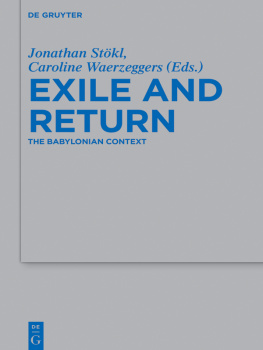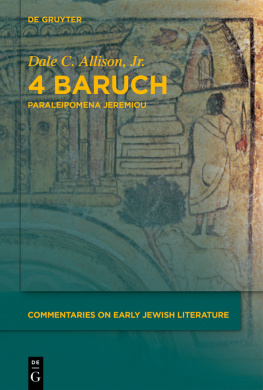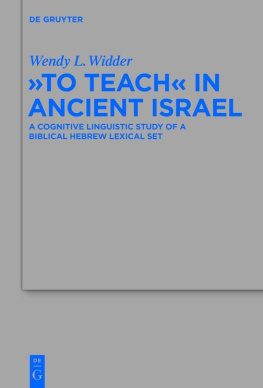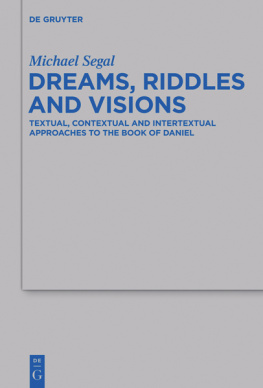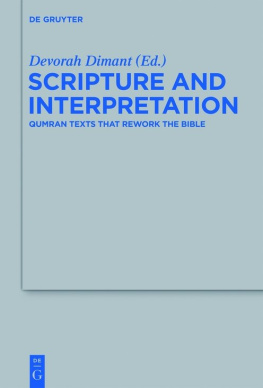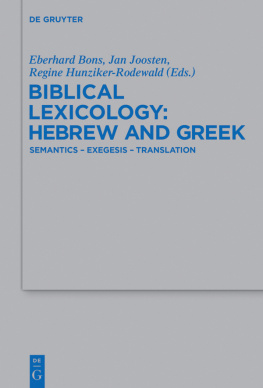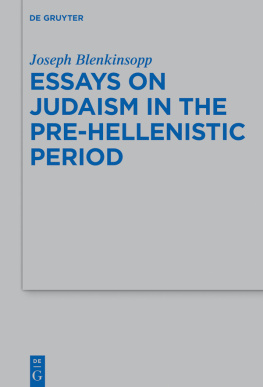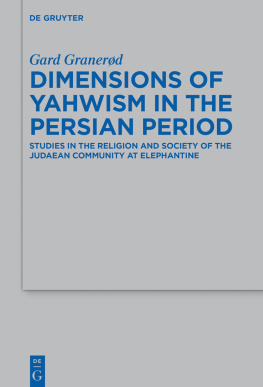Exile and Return
Beihefte zur Zeitschrift
fr die alttestamentliche
Wissenschaft

Edited by
John Barton, Ronald Hendel,
Reinhard G. Kratz and Markus Witte
Volume 478
ISBN 978-3-11-041700-5
e-ISBN (PDF) 978-3-11-041928-3
e-ISBN (EPUB) 978-3-11-041952-8
ISSN 0934-2575
Library of Congress Cataloging-in-Publication Data
A CIP catalog record for this book has been applied for at the Library of Congress.
Bibliografische Information der Deutschen Nationalbibliothek
The Deutsche Nationalbibliothek lists this publication in the Deutsche Nationalbibliografie; detailed bibliographic data are available on the Internet at http://dnb.dnb.de .
2015 Walter de Gruyter GmbH, Berlin/Boston
www.degruyter.com
Table of Contents
Laurie E. Pearce
Identifying Judeans and Judean Identity in the Babylonian Evidence
Kathleen Abraham
Negotiating Marriage in Multicultural Babylonia:
An Example from the Judean Community in l-Yhdu
Gauthier Tolini
From Syria to Babylon and Back: The Neirab Archive
Ran Zadok
West Semitic Groups in the
Nippur Region between c. 750 and 330 B.C.E.
Johannes Hackl and Michael Jursa
Egyptians in Babylonia in the Neo-Babylonian
and Achaemenid Periods
Caroline Waerzeggers
Babylonian Kingship in the Persian Period:
Performance and Reception
Jonathan Stkl
A Youth Without Blemish, Handsome,
Proficient in all Wisdom, Knowledgeable and Intelligent:
Ezekiels Access to Babylonian Culture
H. G. M. Williamson
The Setting of Deutero-Isaiah: Some Linguistic Considerations
Madhavi Nevader
Picking Up the Pieces of the Little Prince:Refractions of
Neo-Babylonian Kingship Ideology in Ezekiel 4048?
Lester L. Grabbe
The Reality of the Return:
The Biblical Picture Versus Historical Reconstruction
Jason M. Silverman
Sheshbazzar, a Judean or a Babylonian? A Note on his Identity
Katherine Southwood
The Impact of the Second and Third-Generation Returnees
as a Model for Understanding the Post-Exilic Context
Peter R. Bedford
Temple Funding and Priestly Authority in Achaemenid Judah
Introduction
Since the appearance of the first l-Yhdu tablets a few years ago, there has been growing awareness among biblical scholars that cuneiform texts from the Neo-Babylonian and Persian periods might offer useful information that will elucidate questions related to the historical reconstruction of the Babylonian Exile, its impact on ancient Judaism and its relevance for understanding certain biblical texts. The l-Yhdu tablets preserve a unique imprint of an actual Judean / Jewish community living in central Babylonia during the period conventionally identified as the era of the Babylonian Exile. It is certainly not the first time that we find evidence of Judean exiles in the cuneiform record Weidners identification of king Jehoiachin in tablets from Nebuchadnezzars palace comes to mind but the l-Yhdu texts offer the most vivid, most complex and most direct testimony of life in the Babylonian Exile so far. Indeed, they appear to be the archives of a Judean community itself. However, the relevance of the cuneiform text corpus for understanding the Exile is not restricted to its preserving the names and actions of concrete individuals affected by it the corpus is so dense and diverse that it reveals the cultural and social context within which not only the individual experiences of the individuals in question need to be interpreted but also those of other deported communities and those of the host society at large. Here, then, is an opportunity to contextualize a formative era in the history of ancient Judaism.
Most biblical scholars would agree that the many books of the Hebrew Bible were either composed in some form or edited during the Exilic and post-Exilic periods among a community that was to identify itself as returning from Babylonian captivity. At the same time, a dearth of contemporary written evidence from Judah/Yehud and its environs renders any particular understanding of the process within its social, cultural and political context virtually impossible. This has led some to label the period a dark age or black box as obscure as it is essential for understanding the history of Judaism. To be fair, such a defeatist view of the Babylonian and Persian periods in Judah/Yehud is not widely shared today, especially not since archaeologists have stepped up their effort to look for and study material remains from the period in recent years. Historians have also added to the momentum by drawing on the advances in the study of Achaemenid Persian history in order to integrate the local history of Yehud, the return from Exile, and the restoration of Jerusalems temple more firmly within the regional, and indeed global, developments of the time. These efforts have increasingly led to a realization that the story of the Exile and return as narrated in the biblical text is a construct that replaces a much more complex and socially contested history. Despite its constructed nature, however, a majority of biblical scholars concedesthat there is some truth in the ExileReturn myth based on the cuneiform and archaeological evidence for Nebuchadnezzars destructive military action in Jerusalem and its environs, and the mention of at least a small group of Judean captives (at court) and colonists (in the countryside) in cuneiform texts from the heartland of Babylonia during and after the sixth century B. C.E.
During the Neo-Babylonian and Persian periods, the time of the Exile, Babylonia produced extraordinarily rich deposits of cuneiform texts, making it one of the very best documented epochs of ancient Mesopotamian history. The archives derive from a variety of settings (private, temple, state) and a range of different sites, from Sippar and Akkad in the north to Ur and the Sealand in the south. Literary, scholarly, legal and administrative texts are all represented in great numbers. For a long time the sheer size of this corpus prevented rather than invited scholars to take advantage of its potential for historical research. This was mainly due to the poor state of publication and inaccessibility of the records but in recent decades this situation has changed dramatically thanks to a combined effort of many Assyriologists. With these recent advances it is now possible not only to catalogue and document each individual mention of a Judean at the time of the Exile but to go further in embedding these occurrences in the deep social texture of the time and against the backdrop of the large political transformations of the Babylonian and Persian Empires. The cuneiform material allows scholars to study the economy, literary traditions, practices of literacy and the ideologies of the host society factors that affected those taken into Exile in variable, changing and multiple ways and to conduct comparative case-studies of the experiences of other exiled groups living alongside the Judeans.
With these new developments in mind, the ERC project By the Rivers of Babylon: New Perspectives on Second Temple Judaism from Cuneiform Texts invited a group of Assyriologists, biblical scholars, and ancient historians with the explicit aim of reflecting on the opportunities and challenges of a Babylonian contextualization of the Babylonian Exile within the context of recent advances in the study of the Babylonian text corpus and the growing interest in the effect of the Exile on the identity and theology of second Temple Judaism. The meeting, held at UCL on 1012 November 2011, was organized around two topics: sources and interactions. In the first part of the meeting, we invited papers on the latest additions to the documentary evidence pertaining to the Judean Exilic community or other communities of deportees in Babylonia. In the second part, we invited papers on the interactions between the Exilic community and its Babylonian environment in the broadest sense, e.g. onomastics and other philological issues, social networks and intermarriage, settlement patterns and interactions with imperial administrations, religious authorities and ideologies of kingship.Alternatively, papers were to look at changes that became visible in the repatriated community during the restoration period in Jerusalem. For instance, changes in social structure, the appearance of the institution of the 
Next page
